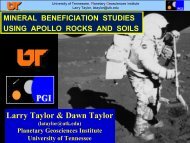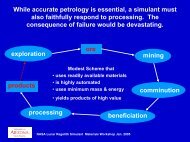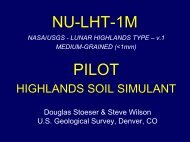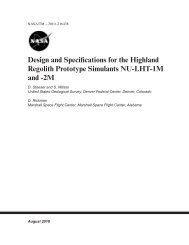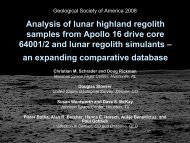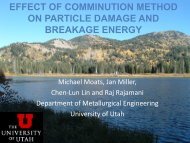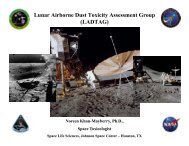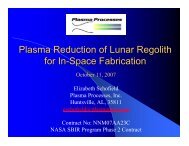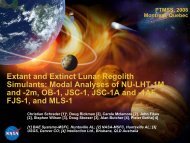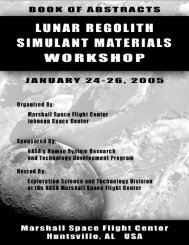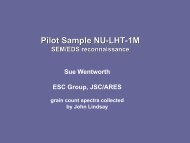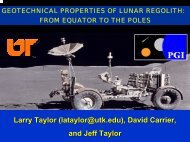Figure of Merit Characteristics Compared to Engineering Parameters
Figure of Merit Characteristics Compared to Engineering Parameters
Figure of Merit Characteristics Compared to Engineering Parameters
You also want an ePaper? Increase the reach of your titles
YUMPU automatically turns print PDFs into web optimized ePapers that Google loves.
is common practice for geologists who, by training and experience, understand the meaning bycontext. Because the majority <strong>of</strong> simulant users and developers are not geologists, the simulantdevelopment project explicitly decided <strong>to</strong> restrict grain <strong>to</strong> mean a discrete subset <strong>of</strong> a particle. Allparticles in lunar regolith or simulant will be comprised <strong>of</strong> glass and/or mineral grains, but particlesmay be amalgams <strong>of</strong> grains that result in lithic fragments (rock particles) or agglutinates.Therefore, the first order <strong>of</strong> classification <strong>of</strong> constituents includes mineral grains, glassgrains, lithic fragments, and agglutinates. Measuring proportions <strong>of</strong> particle types by volume isknown in geologic science as a modal analysis and is usually reported in modal percent by eachconstituent. Although it is not required by the FoM, it is ideal that modal analyses be obtainedfor a material in several different size fractions. This is because the percentages <strong>of</strong> constituents <strong>of</strong>any bulk material will tend <strong>to</strong> vary by size due <strong>to</strong> differential susceptibility <strong>to</strong> grinding and crushing.Modal analyses for lunar highlands regolith have been published (e.g., reference 4). These dataserve as the basis for the regolith simulant team’s reference material in the FoM algorithm, butmore precise data are being gathered <strong>to</strong> augment them.2.2.2 Particle Size DistributionFor the FoM, particle size is measured on a particle-by-particle basis and reported as adistribution. The number <strong>of</strong> bins and the size <strong>of</strong> the bins are defined by the user, but a more preciseFoM evaluation is rendered by an approximation <strong>to</strong> the lunar regolith dataset. For instance, thesedata can be found in The Lunar Soils Grain Size Catalog. 52.2.3 Particle Shape DistributionParticle shape is a crucial parameter in determining many geotechnical properties such asabrasiveness and bulk shear strength. The FoM calls for measurement <strong>of</strong> shape on a particle-byparticlebasis, which is then reported as a distribution. Shape is described by two parameters,aspect ratio and sphericity. The specific algorithms for measuring these characteristics are beingdetermined.2.2.4 DensityDensity as an FoM parameter refers <strong>to</strong> bulk density, and it is the only parameter that is notmeasured by the particle but as a bulk characteristic. The measurements that comprise the densityFoM are minimum bulk density, maximum bulk density, and specific gravity. Measured as such, thebulk density FoM conveys information as <strong>to</strong> the specific gravity <strong>of</strong> the constituent particles and onthe packing (i.e., the bulk relationship <strong>of</strong> the particles <strong>to</strong> one another). It is the FoMproperty most easily affected by handling <strong>of</strong> the simulant.4



